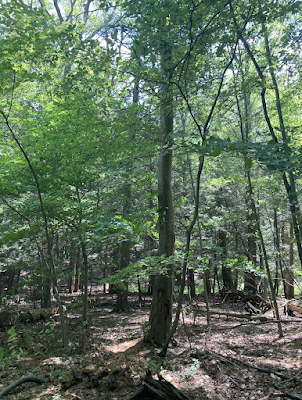A Forest Sounds Like a Ship at Sea:
Sequoia of the East
Day 4: Remote Residency at Uillinn: West Cork Arts Centre, Skibbereen, Ireland, 7/18/22 to 8/13/22, Maria Driscoll McMahon checking in from New York State
 |
| There are few things as beautiful to my eyes as these funny, spiky, little balls that look more like they were dreamed up by Hayao Miyazak than produced by a tree largely extirpated from the American arboreal landscape. |
I met a chestnut tree today! A real American Chestnut!
The introduction was provided by my friend, River Santina, who knows heaps about the flora and fauna of the region. River can not only name names, she can describe intricate details about plant characteristics. When she told me she knew the location of a chestnut tree, I begged for a viewing! I didn't have to plead too much, though; she was more than happy to show me. In my heart, I was not sure how I would react. Since the story of the American Chestnut is an American environmental tragedy, I was totally expecting to collapse in tears at the sight of what I was anticipating would be a pathetic sapling struggling to grow, ambitious, but doomed from the get-go.
Happily I was wrong! The tree actually exceeded the scale of many of its neighboring trees! I was filled with joy and awe that it was able to survive so long.
In a "nut shell," here's the saga of the magestic tree that was known as the "sequoia of the east." According to many sources, chestnut trees dominated the 19th century forests, comprising between 30 - 40 percent of Pennsylvania forests. The trees were not just grand in stature, they provided food for countless animals including human beings. Their wood was rot resistant and used to build homes and furniture. Their loss was not just an environmental tragedy, it was also an economic disaster.
The infamous chestnut blight was responsible for the death of nearly three billion trees in the eastern United States...due to the deadly fungus around 1903 due to a nursery of infected Asiatic Chestnut trees being imported into New York City...The infection quickly spread...By the year 1940, over the course of thirty years, the fungus managed to kill all but a few Chestnut trees in Pennsylvania.
The Demise of the American Chestnut – (paconservationheritage.org)
 |
| Loggers around 1900-1901 in the southern Appalachians in a grove of very large American chestnuts. Library of Congress. Forests of a Century Ago – The Dominance of American Chestnuts | Department of Biology (appstate.edu) |
Today, very few American Chestnuts survive. Scientists are trying to increase resistance to the blight through genetic engineering, but it will be some time before the trees will ever proliferate as they once did.
It is also fascinating to note that the roots of the chestnut tree do not die, but continue to send up shoots fated, of course, to wither as they, too, succumb to blight.
And yet, these shoots succeed in bringing hope, and sometimes the shoots become actual trees as was the case for the tree I experienced today. It was also delightful to see the many chestnut burrs strewn about the ground! Where there is life, there is hope!
Closer inspection of the tree, however, told a more somber story. While this tree is an over-achiever, it, too, is not invulnerable to the deadly fungus as seen below.
The fungus called Cryphonectria parasitica enters the cracks in the tree and spreads what is known as a canker disease. The cankers are of the diffuse type. They grow rapidly and in most cases continue to develop until the stem is girdled and killed; then they continue to colonize the dead tree.
Chestnut Blight: An American Tragedy | Forest Pathology
 |
| The crumbly red substance is blight that has gotten into the cracks of the tree and has spread. |
 |
| Sadly, another view of the tree reveals the dead canopy. |
Meanwhile, however, one of the shoots coming off the trunk still looks quite healthy! The tiny round protrusions are called "lenticels" which River tells me "help with the passage of air."
 |
| I could not do this project without the help of people with much knowledge of natural science - the botany and biology of the flora and fauna. Many thanks to River! |




No comments:
Post a Comment